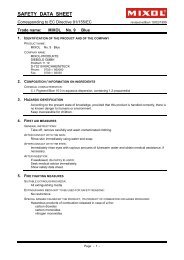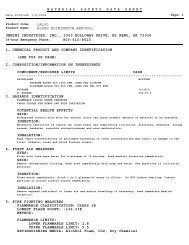G39 Z-Poxy.pdf - Wood Finisher's Depot
G39 Z-Poxy.pdf - Wood Finisher's Depot
G39 Z-Poxy.pdf - Wood Finisher's Depot
Create successful ePaper yourself
Turn your PDF publications into a flip-book with our unique Google optimized e-Paper software.
MATERIAL SAFETY DATA SHEET DATE: 02/12/02<br />
Revision #1 Page 1 of 2<br />
Section 1<br />
For Chemical Emergency Only:<br />
PACER TECHNOLOGY HAZARD RATING In the US & Canada (800) 424-9300<br />
9420 Santa Anita Avenue 1 Int'l & Wash DC (COLLECT) (202) 483-7616<br />
Rancho Cucamonga, CA 91730 2 x 0 Telephone for Information: (909) 987-0550<br />
PRODUCT IDENTIFICATION: Z-<strong>Poxy</strong> 30 Minute Formula - Resin - Part A<br />
Section 2 - HAZARDOUS INGREDIENTS INFORMATION:<br />
Hazardous Components OSHA ACGIH OTHER %<br />
(Common Names, CAS Number) PEL TLV LIMITS OPTION<br />
Bisphenol A/Epichlorohydrin<br />
based epoxy resin* (25068-38-6) NE NE NE 60-100%<br />
* This product is an epoxy resin produced by the condensation reaction of Epichlorohydrin and<br />
Bisphenol-A. These raw materials are consumed in the process. Residual levels of Epichlorohydrin are<br />
controlled to 1ppm, max, in the product.<br />
Section 3 - PHYSICAL/CHEMICAL CHARACTERISTICS:<br />
Boiling Point: >500F Specific Gravity (H2O=1): 1.17<br />
Vapor Density (Air=1): NA Melting Point: NE<br />
Vapor Pressure (mm Hg): 0.03 @ 77F Evaporation Rate (Butyl Acetate = 1): NA<br />
Solubility in Water: Negligible.<br />
Appearance & Odor: Light yellow colored viscous liquid.<br />
Section 4 - FIRE AND EXPLOSION HAZARD DATA:<br />
Flash Point (Method Used): 480F (PMCC) Flammable Limits: LEL: NE UEL: NE<br />
Extinguishing Media: Water fog, foam, dry chemical or carbon dioxide.<br />
Special Fire Fighting Procedures: Material will not burn unless preheated. Do not enter confined fire<br />
space without full bunker gear (helmet/face shield, bunker coat, gloves & rubber boats). Use positive<br />
pressure NIOSH-approved self-contained breathing apparatus. Cool fire exposed containers with<br />
water.<br />
Unusual Fire and Explosion Hazards: Heating of resin above 300F in presence of air may cause slow<br />
oxidative decomposition. Above 500F polymerization may occur. Some curing agents, e.g. aliphatic<br />
amines can produce exothermic reactions which in large masses can cause runaway polymerization &<br />
charring of reactants. Fumes & vapors from these thermal & chemical decompositions vary widely in<br />
composition/toxicity. DO NOT BREATHE FUMES. Unidentified fumes & vapors may be toxic.<br />
Section 5 - REACTIVITY DATA:<br />
Stability: Stable XX Conditions to Avoid: Keep away from open flames & high temperatures.<br />
Incompatibility (Materials to Avoid): Strong oxidizing agents, strong Lewis or mineral acids, strong<br />
mineral & organic bases, esp. primary & secondary aliphatic amines.<br />
Hazardous Decomposition Products: Carbon monoxide, aldehydes, acids & other organic substances<br />
may be formed during combustion (>500F) temperature degradation.<br />
Hazardous Polymerization: May Occur __ May Not Occur XX (Avoid heating >300F).<br />
Section 6 - HEALTH HAZARD DATA:<br />
Route(s) of Entry: Inhalation: YES Skin: YES Ingestion: YES
MATERIAL SAFETY DATA SHEET Z-<strong>Poxy</strong> 30 Minute Formula - Resin - Part A Rev 1 Page 2 of 2<br />
Health Hazards (Acute and Chronic):<br />
Product moderately irritating to eyes, skin; contact with product at elevated temperatures can result<br />
in thermal burns; may cause skin sensitization; low order of acute oral toxicity noted; unlikely to be<br />
inhalation hazard due to low volatility.<br />
Carcinogenicity: NTP: No IARC Monographs: No OSHA Regulated: No<br />
First Aid Procedures:<br />
Eye contact - irritation: flush eyes with copious amounts of water for 15 min. while holding eyes<br />
open. Get medical attention immediately.<br />
Skin contact - irritation/rash: remove contaminated clothing and wash with soap/water. Get medical<br />
attention if symptoms persist (contaminated leather articles i.e. shoes should be disposed of as<br />
contaminated waste). NOTE: hot product burns require immediate medical attention.<br />
Inhalation - Remove to fresh air and provide oxygen if breathing is difficult. Get medical attention.<br />
Ingestion - Do not induce vomiting. In general, no treatment unless large amount is ingested,<br />
however, get medical advice.<br />
NOTE TO PHYSICIAN: Emesis induction is normally not necessary in high viscosity, low volatility<br />
products, e.g. neat epoxy resins.<br />
Medical Conditions Generally Aggravated by Exposure: Pre-existing eye/skin disorders or lung<br />
allergies.<br />
Section 7 - PRECAUTIONS FOR SAFE HANDLING AND USE:<br />
Steps to Be Taken in Case Material is Released or Spilled: Product may burn although not readily<br />
ignitable. Use cautious judgment when cleaning up large spills. Respirator and protective equipment<br />
as appropriate. Dike and contain material. Soak up residue with absorbent (clay, sand) materials and<br />
dispose of properly.<br />
Waste Disposal Method: If product becomes waste, not considered hazardous waste by RCRA criteria<br />
(40 CFR 261). Dispose of according to federal, state and local regulations.<br />
Precautions to Be Taken in Handling and Storing: Store in cool, dry place away from open flames<br />
and high temperatures.<br />
Other Precautions: Empty containers may contain product residues & should be disposed of properly.<br />
Section 8 - CONTROL MEASURES:<br />
Respiratory Protection (Specify Type): Organic vapor respirator in areas with poor ventilation.<br />
Ventilation: Local Exhaust: Good Mechanical (General): As needed.<br />
Protective Clothing or Equipment: Safety glasses/goggles with side shields, chemically resistant<br />
gloves and other protective equipment to avoid direct contact.<br />
Work/Hygienic Practices: Avoid contact with eyes or skin. Use in well ventilated area. Wash hands<br />
with soap and water after product use. Launder contaminated clothing before reuse and disposed of<br />
leather articles as contaminated waste.<br />
NA = Not applicable<br />
NE = Not established<br />
The data contained herein is based upon information that Pacer Technology believes to be reliable.<br />
Users of this product have the responsibility to determine the suitability of use and to adopt all<br />
necessary precautions to ensure the safety and protection of property and persons involved in said<br />
use. All statements or suggestions are made without warranty, express or implied, regarding<br />
accuracy of the information, the hazards connected with the use of the material or the results to be<br />
obtained from the use thereof.
MATERIAL SAFETY DATA SHEET DATE: 2/12/02<br />
Revision #2 Page 1 of 2<br />
Section 1<br />
For Chemical Emergency Only:<br />
PACER TECHNOLOGY HAZARD RATING In the US & Canada (800) 424-9300<br />
9420 Santa Anita Avenue 1 Int'l & Wash DC (COLLECT) (202) 483-7616<br />
Rancho Cucamonga, CA 91730 3 x 1 Telephone for Information: (909) 987-0550<br />
PRODUCT IDENTIFICATION: Z-<strong>Poxy</strong> 30 Minute Formula - Hardener - Part B<br />
Section 2 - HAZARDOUS INGREDIENTS INFORMATION:<br />
Hazardous Components OSHA ACGIH OTHER %<br />
(Common Names, CAS Number) PEL TLV LIMITS OPTION<br />
Proprietary Mercaptan Polymer NE NE NE 60-100<br />
Tertiary Amine (90-72-2) NE NE NE 5-10<br />
Tris (Dimethyl Aminomethy) Phenol Trihexoate NE NE NE 1-5<br />
Phenol + (108-95-2) 5ppm 5ppm (skin) *=
MATERIAL SAFETY DATA SHEET Z-<strong>Poxy</strong> 30 Minute Formula-Hardener-Part B Rev 2 Page 2 of 2<br />
Carcinogenicity: NTP: No IARC Monographs: No OSHA Regulated: No<br />
First Aid Procedures:<br />
Eye contact - Irritation: immediately flush eye with copious amounts of water for 15 minutes. Get<br />
medical attention.<br />
Skin contact - Irritation upon direct contact. Remove contaminated clothing and wash affected areas<br />
with soap and water.<br />
Inhalation - Remove to fresh air. Administer oxygen if available.<br />
Ingestion - Do not induce vomiting. Keep airway clear if vomiting occurs.<br />
Medical Conditions Generally Aggravated by Exposure: Pre-existing skin/eye/lung conditions.<br />
Section 7 - PRECAUTIONS FOR SAFE HANDLING AND USE:<br />
Steps to Be Taken in Case Material is Released or Spilled: Stop leaks & contain spill. Soak up with<br />
absorbent material for disposal in proper container, wearing adequate protective clothing/respiratory<br />
protection.<br />
Waste Disposal Method: In chemical landfill or incinerate in accordance with federal, state or local<br />
regulations.<br />
Precautions to Be Taken in Handling and Storing: Do not store near epoxy resin, protect containers to<br />
avoid leaks and spills.<br />
Other Precautions: CAUTION - May cause irritation. Avoid direct contact or breathing of mist or<br />
vapor. Use with adequate ventilation and use respiratory protection where mist or vapor may be<br />
generated. For industrial use only. Keep containers closed when not in use.<br />
Section 8 - CONTROL MEASURES:<br />
Respiratory Protection (Specify Type): Organic vapor respirator to avoid inhalation of mist or vapor.<br />
Ventilation: Local Exhaust: Good Mechanical (General): As needed.<br />
Protective Clothing or Equipment: Safety glasses/goggles with side shields, rubber gloves, chemical<br />
resistant shoes and protective clothing to avoid direct contact.<br />
Work/Hygienic Practices: Avoid direct contact or breathing of mist or vapor. Use with adequate<br />
ventilation. Wash hands with soap and water after use. Launder contaminated clothing before reuse.<br />
Do not take internally.<br />
NE = Not established<br />
The data contained herein is based upon information that Pacer Technology believes to be reliable.<br />
Users of this product have the responsibility to determine the suitability of use and to adopt all<br />
necessary precautions to ensure the safety and protection of property and persons involved in said<br />
use. All statements or suggestions are made without warranty, express or implied, regarding<br />
accuracy of the information, the hazards connected with the use of the material or the results to be<br />
obtained from the use thereof.











